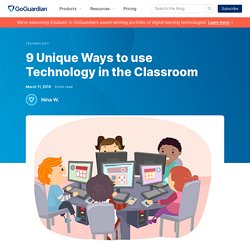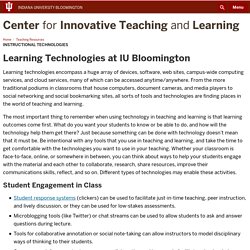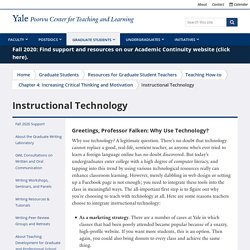

How to Integrate Technology. Below you will find a quick overview with suggestions of what kinds of tools and activities are best matched with various levels of technology access. All of the resources linked to are either free or offer free versions. If your class has an interactive whiteboard and projector: Try interactive websites such as BrainPOP.
Dig in to Scholastic's whiteboard activities page. Show online videos related to the lessons. If there is only one computer in your room: All of the above, plus… Assign one student to be the class scribe and take notes. If you have a pod of three to five computers in the classroom or access to a library with a pod of computers: All of the above, plus… Encourage individual student blogging using Kidblog. If you have access to a laptop cart or a computer lab: All of the above, plus… Enable students to work through course content at their own pace through the use of screencasts, e-books, and other digital media.
How to use technology in the classroom - CAE Computer Aided E-learning. Technology in the classroom now plays a very big role in the effectiveness of education.

Whether your students are five or fifty, it has become expected for teachers and tutors to utilise technology in order to better communicate course material. Many educational organisations offer courses that no longer need to take place in a traditional classroom. This includes language schools, universities and training course providers, many of which now offer a wide range of multimedia courses online. However, the choice here is not a matter of deciding on the traditional method or the digital one. Schools and other training providers don’t have to decide whether to offer their courses on a solely online or offline basis. Though online multimedia courses are an excellent option for many, a lot of students still prefer the face to face camaraderie of attending physical classes. Want to increase the effectiveness of what you are doing in the classroom? #1. . #2. . #3. . #4. You may also like: 9 Unique Ways to use Technology in the Classroom.
Finding creative ways to use technology in the classroom can both make your life easier as a teacher and boost student excitement levels and engagement with lessons.

From helping with communication among teachers and students (as well as peer-to-peer), to organizing curriculum calendars, to enhancing presentations and lessons with media and visuals, there is no limit to the ways to use technology in the classroom to create an enriched learning environment. If you’re looking for ideas of exactly how to use technology in the classroom to enhance learning, some examples include: Gamified learningDigital field tripsIntegrate social mediaGather student feedbackCreating digital contentUsing a shared, online classroom calendarReview and critique webpagesIncorporate video and multimedia into lessons and presentationsOnline activities for students who finish work early 1.
Gamified Learning 2. 3. 4. #QTNA (questions that need answers!) 5. 6. 7. 8. 9. Instructional Technologies: Teaching Resources: Center for Innovative Teaching and Learning: Indiana University Bloomington. Learning technologies encompass a huge array of devices, software, web sites, campus-wide computing services, and cloud services, many of which can be accessed anytime/anywhere.

10 of the Most Engaging Uses of Instructional Technology (with Dozens of Resources and Tools) Are you looking for ways to integration technology in your lesson plans and courses that provide for an engaging experience for you and your students? Fans of instructional technology know that it can be fun and inviting, and engaged students are far more likely to be learning. I believe that if you can get students involved and motivated effectively enough, you can improve their learning habits over the long term. With that in mind, here are 10 highly engaging uses of technology in the classroom, along with dozens of tools and resources for implementation. Most of these involve free web based tools, so that's an added bonus!
Interactive Collaboration The 2014 Gates Foundation report, Teachers Know Best: What Educators Want from Digital Instructional Tools, indicates that teachers want tools “supporting student collaboration and providing interactive experiences”. Gathering Feedback Embedding Questions in Videos Today’s students consume video like drinking water. 8 Innovative Ways To Use Technology in Education. Recent research states that the use of technology in education has improved student’s academic performance drastically. Though traditional classroom teaching may still be prevalent, many educational instituitions are coming forward in embracing technologies. For instance, they use digital whiteboards, flipped classrooms and Chromebooks replacing textbooks.
How to Use Education Technology - The Ultimate Guide. In his popular book, Ditch That Textbook, Matt Miller argues that the textbook is a relic from the days when teachers were the keepers of knowledge to be delivered to students in healthy doses of lectures and notes.

The fact of the matter is that in today’s digital world, educators are no longer the gatekeepers of information, and students know it. Instead, the role of the educator should be to guide students as they navigate the wealth of information available at their fingertips. Breaking free from textbooks doesn’t have to mean doing away with them entirely, but it does mean that educators need to be using relevant digital media to supplement material.
Whether we choose to show them or not, students are going to find information online. We should embrace the availability of the vast array of multimedia sources and guide students toward what is the most interesting, relevant, and useful. Education Technology: What Is Edtech? A Guide. How Does Edtech Help Students & Teachers?

Students An influx of technology is opening up new avenues of learning for students of all ages, while also promoting collaboration and inclusivity in the classroom. Here are five major ways edtech is directly impacting the way students learn. Tech-Infused Classrooms are Shaping Elementary Education 1. Cloud-enabled tools and tablets are fostering collaboration in the classroom. How Cloud Computing Is Transforming Education, Mostly For the Better. Educational Technology and Mobile Learning.
K-12 & College Educational Technology: Classroom Tools & Resources. Poorvu Center for Teaching and Learning. Greetings, Professor Falken: Why Use Technology?

Why use technology? A legitimate question. There’s no doubt that technology cannot replace a good, real-life, sentient teacher, as anyone who’s ever tried to learn a foreign language online has no doubt discovered. But today’s undergraduates enter college with a high degree of computer literacy, and tapping into this trend by using various technological resources really can enhance classroom learning. However, merely dabbling in web design or setting up a Facebook page is not enough; you need to integrate these tools into the class in meaningful ways. As a marketing strategy. Technology in the Classroom in 2019: 6 Pros & Cons. Technology in education is the biggest change in teaching we will ever see. For years, policy makers, teachers, parents and students alike have been weighing the potential benefits of technology in education against its risks and consequences. But now the debate is more pressing than ever, as curricula increasingly incorporate technology and professors experiment with new teaching methods.
On one hand, technology allows you to experiment in pedagogy, democratize the classroom and better engage students. On the other hand, some argue technology in the classroom can be distracting and even foster cheating.